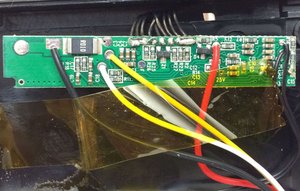I just tested the controller chip of a battery that died today. I did carefully desolder and remove the four wires leading to the battery three battery packs inside the battery housing.
As we can see, a temperature sensor is present
BTW the wire colors from the first image of this thread: Black-Ground / White and Yellow - measuring voltages between cells for balancing / Red - about 11V Voltage
With the PCB attached, battery shows 0% on startup and the Mac is as slow as without battery. It also forces itself to shutdowns. (Macbook Pro late 2011 17" / 10.13.6)
I also found this interesting article about an Macbook Pro battery teardown:
https://www.edn.com/teardown-debugging-a...
Two Ideas:
1) -With the correct voltages present at the PCB, shouldn't the Mac be tricked into "thinking" a battery was present?
As far as I understand it is 3.7V cells, so very likely 3x3.7V in series = 11.1V (Printing on the battery reads 10.95V)
Leaving the bottleneck of a weak power supply aside for a moment I assume feeding the the battery controller PCB with about 10V from the Mac circuitry could do the trick? Maybe using a diode to prevent charging current being fed back to the DC input?
I also assume that the sensing / balancing cables need to measure 1/3 and 2/3 of the power...?
2 - with some explanation beforehand)
What is frustrating that a faulty battery will swell. Mine did today and I was somehow lucky. The Mac bulged but not yet visible to the eye.
I realised this when the lid did not close completely. I immediately removed the battery, the bulging is gone, but there are cracks in the anodising layer around the Trackpad. (Aluminium oxide brittles like glass) A tad frustrating for a machine that I cared a lot for and that looks brand new after 13 years of use.
Anyway, to get around the problem, instead of buying a new battery why not buying three 3.7V Li-ION cells and attaching them to the battery controller PCB?
Those could be better controlled by the eye and there is no dependency on suppliers.
Question: In my case, they do not need to have much capacity, just to provide enough power while the CPU needs it. I read in the article linked above that the charging current reaches 1A. Is the charging current dependent from the capacity of a cell?
All the best, Herbert
Questa risposta è stata utile?
Votato
Annulla
Punteggio
0
Annulla
Scorri questo thread per trovare il posto appropriato per questo commento. Quindi, fai clic su "Allega commento a questo post" per spostarlo.


 2
2 
 54
54  291
291 
